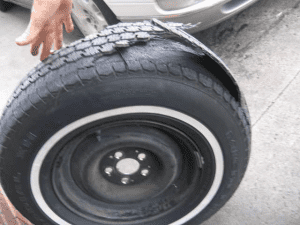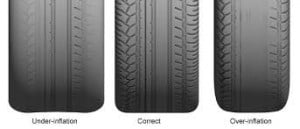
This is the bathtub curve we are often shown.
This is what a real bathtub curve looks like.
A real bathtub curve would capture all the different types of failure modes, represented by each of these lines. We typically talk about a failure mode being placed in one of the three categories, Quality (infant Mortality), Use stress, or Wear-out. But in fact any specific type of failure mode may have driving factors in multiple categories. The same failure mode may have a sensitivity to manufacturing variability but show up, same symptoms, and physics of failure, in wear-out. It is understanding the stresses that drove the failure mode and how they relate to use case and environment definitions.
As a refresher, these are the three phases of product life characterized in the Bathtub curve.
- Infant Mortality: Failure modes driven by quality/manufacturing defects. These failure modes show up very early in life and quickly tapper to a very low failure rate.
- Use Life: These are failures that are driven by variability in use and environment. The shape of this failure mode can be varied. When the shape is unknown is it usually characterized as a constant failure rate. It is a good initial assumption for full product because each component/subsystem will have a different shape. Added together they may create a static failure rate at a set level.
- Wear-out: These failure modes are predictable. They are unique in that they are guaranteed to happen and are a direct result of design characteristics. They typically show up as a low failure rate for a population and then continue to increase at an accelerated rate.
Here are examples of the different types of failure modes for a car tire
- Infant Mortality: Tread separates from base layers of tire in first 5,000 miles
- Use Life: Puncture or loss of tread due to gouging at 15,000 miles
- Wear-out: Tread wears down until traction is reduced at 50,000 miles.
 You can see in this case that the Infant Mortality failure rate was clearly due to poor bonding between the tread layers. The Use Life failure was because the terrain may have been rougher than the planned stresses or the design was not fully matured and able to handle the use case specified for the customer. The Wear-out was a predictable failure mode that can be communicated to the customer in advance of the purchase. If it has been correctly measured in product development and defined in the product specifications, then there is no disappointment from the customer when it occurs.
You can see in this case that the Infant Mortality failure rate was clearly due to poor bonding between the tread layers. The Use Life failure was because the terrain may have been rougher than the planned stresses or the design was not fully matured and able to handle the use case specified for the customer. The Wear-out was a predictable failure mode that can be communicated to the customer in advance of the purchase. If it has been correctly measured in product development and defined in the product specifications, then there is no disappointment from the customer when it occurs.
But what I have outlined is a very clean cut characterization. In real life it takes a long time to get to where the observed failure modes can be so neatly characterized. Before this was well understood the development experience may have been more along the lines of this.
- The tire tread separated from the base layer at 5000 miles.
- We don’t know why this happened
- Root cause shows the thermal heat bond failed.
- Was it a defective bond? Was it that the tire duty cycle was too high in testing? Maybe this wouldn’t happen to a customer because they don’t use it this way? Maybe this is the wear-out failure mode and all tires will fail at around 5000 miles with a delamination and we should tell customer’s to expect this as “end of life”?
 That’s a lot of questions to answer and each requires an investigation that is either analytical, testing, or both.
That’s a lot of questions to answer and each requires an investigation that is either analytical, testing, or both.
So don’t be frustrated as you generate data for your product through test and can’t create a clear failure rate distribution right away. There is a lot to learn about your different failure modes and how they should be categorized and addressed. Be persistent in requesting time and resource to continue testing programs. The end result of understanding your product performance with such detail will enable program decisions to be made with great confidence.
-Adam


 Ask a question or send along a comment.
Please login to view and use the contact form.
Ask a question or send along a comment.
Please login to view and use the contact form.
I have read in various texts that the bathtub curve is just a representation of a population of products. It’s not a curve that actually exists, per se, it’s to show how it is actually three curves. Like for example I couldn’t use it for a pump for example and say “well at this point in time the pump is here on the curve” ?
Thanks
Derek